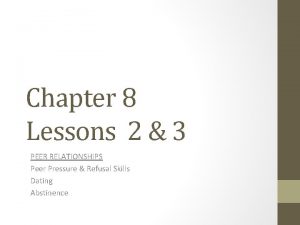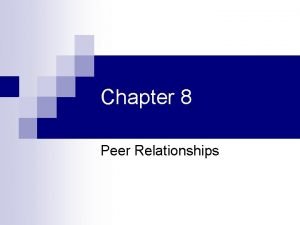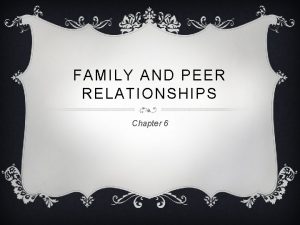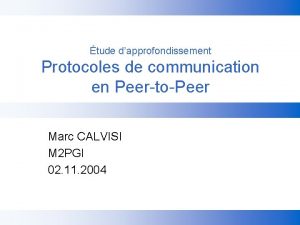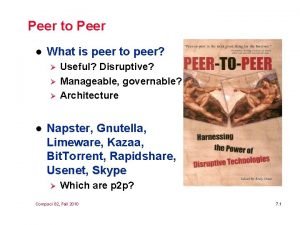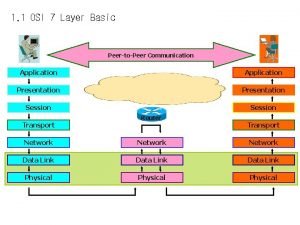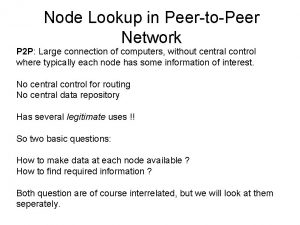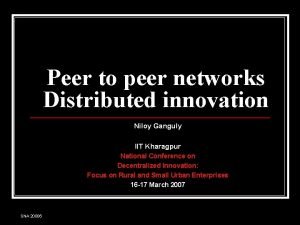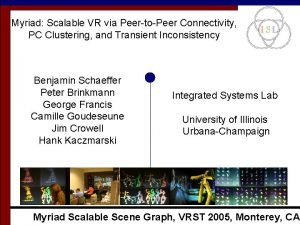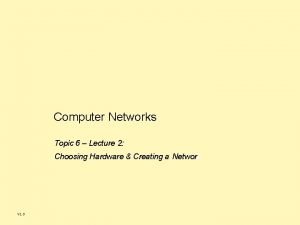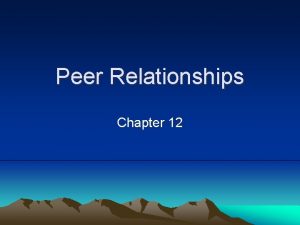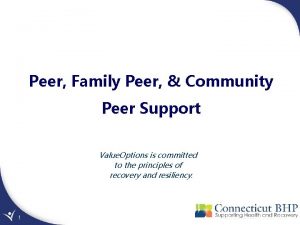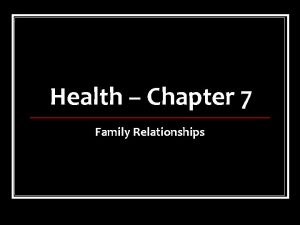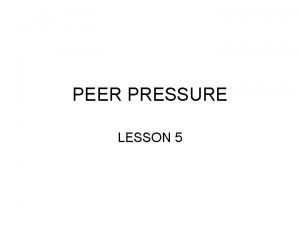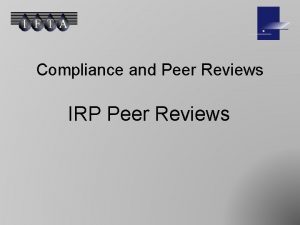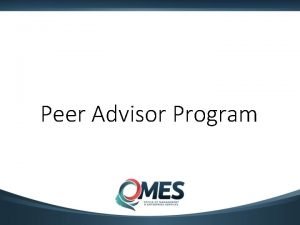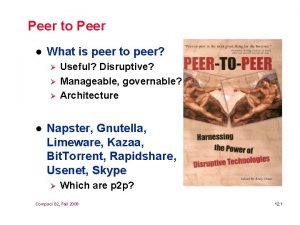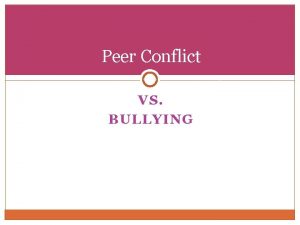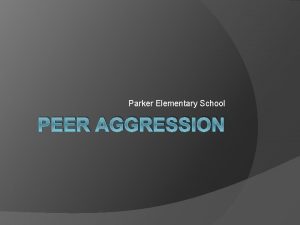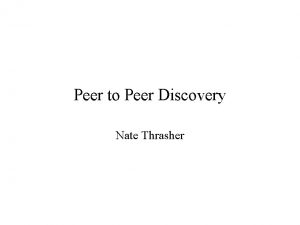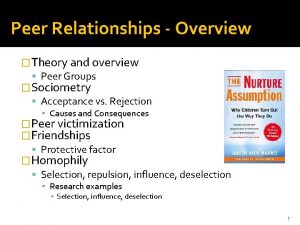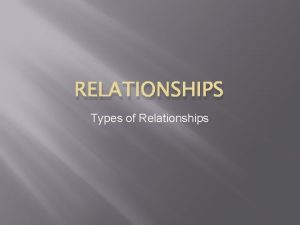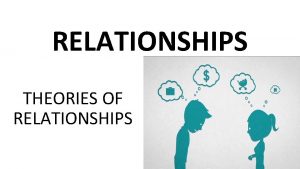FAMILY AND PEER RELATIONSHIPS Chapter 6 6 1


























- Slides: 26

FAMILY AND PEER RELATIONSHIPS Chapter 6

6: 1 FRIENDSHIPS

TYPES OF FRIENDSHIPS v Acquaintances are people you know but who are not your close friends v Good Friends are people you see often. You spend enough time with them to know each other quite well v Close Friend/Best Friend are usually only a few people in your life

WHAT IS A FRIEND? v What qualities do you look for in a friend? v In order for a friendship to develop both people must have similar traits for the friendship to grown • • • Someone with whom you can talk Someone who accepts you Someone who supports you Someone you can trust Someone who is open

WHY DO YOU NEED FRIENDS? v Friendships take time and commitment to develop. v Benefits of Friendship • • Helps you to mature intellectually, emotionally and socially Get to know yourself better Source of companionship Contribute to personal development

WHY DO YOU NEED FRIENDS? v Can help you know and understand your own thoughts and feelings v Help you to accept yourself as a person and increase your self-esteem v Helps you develop empathy (an emotion in which you feel what another is feeling) v Increase you communication skills v Learn how to work cooperatively v Satisfy the need for companionship v Prepare for future lone-term relationships

DEVELOPING A CLOSE FRIENDSHIP v How do you develop a friendship? v What qualities do you have for building a friendship? v What qualities are you looking for in a friend?

DEVELOPING A CLOSE FRIENDSHIP v Be Friendly v Develop Rapport • An atmosphere in which the other person feels comfortable and wants to talk v Share Yourself v Build Trust • Most relationship MUST have • For trust to develop and grow, both people must believe the other person is honest • Both must believe information share will not be used against them in any way

DEVELOPING A CLOSE FRIENDSHIP v Respond with empathy v Be open to growth • Blind spots – your blind spot are factors that you did not know about yourself

THE GOAL OF A CLOSE RELATIONSHIP v Experience fulfillment through sharing in the areas of intellectual, emotional, spiritual or physical v A friendships may provide a few of the areas but a marriage can provide in all these areas v Commitment

PEER RELATIONSHIPS v Your peers are at the same stage of their life path as you

HANDLING NEGATIVE PEER PRESSURE v Passive- go along with what is said or the group v Aggressive behavior – yelling, calling names, criticizing, etc. will often lead to more intense violence v Assertive- letting peers know what you think and feel by using good communication skills, this is the best way to respond

HANDLING BULLYING v Using aggressive behavior to intentionally harm another person is called bullying v Bullying is a sing of social immaturity because bullies are not concerned about the well-being of others

BULLYING 1. Physical Bullying – punching, poking, hair-pulling, beating 2. Emotional Bullying – rejecting, defaming, humiliation, blackmailing, manipulation friends, isolating, pressuring peers 3. Sexual Bullying – exhibitionism, requests for sexual activities, sexual harassment, abuse involving physical contact and assault 4. Verbal Bullying – name calling, teasing, gossip

CYBERBULLYING v Using technology such as internet or cell phones to send hurtful or threating messages to another person 1. Spreading lies or rumors through e-mail or instant message 2. Registering another person form something online without permission 3. Posting pictures with the subject’s permission

6: 2 RELATIONSHIPS IN THE FAMILY

FACTORS INFLUENCING FAMILY RELATIONSHIPS v How well do family members know each other? v How much time do family members spend together? v What common interest do family members share? v What kind of communications occur in the family? v Does acceptance and support exist in the family? v Does love and concern exist in the family?

UNDERSTANDING YOUR PARENT’S POINT OF VIEW v Your parent’s point of view v Cultural role expectations v Providing for the family v Support network v Protect the well-being of the family

PARENT-TEEN CONFLICT v Adjusting to changes such as teen’s independence v Different point of view

NEGOTIATING SOLUTIONS v Shows a positive attitude v Good communication skills

RELATIONSHIPS WITH SIBLINGS v Encourage each other v Sibling rivalry v With a close sibling relationship it can be the core of a strong support group

6: 3 RELATIONSHIPS IN THE WORLD AROUND YOU

RELATIONSHIPS WITH SIGNIFICANT ADULTS v Significant Adults • Grandparents, aunts, uncles, teachers, youth leaders, religious leaders, coaches • Relationships is usually less stressful than with parents

WORK RELATIONSHIPS v Customer Relations • Friendly services v Relating to Fellow Employees v Relationship with Supervisors

RELATIONSHIPS WITH PEOPLE OF OTHER CULTURES v Multiculturalism – a society with people of different cultural backgrounds v Diversity – the unique qualities of people form different cultural backgrounds

ACCEPTING DIFFERENCES v Getting to know people v Meeting people of other cultures v Take the initiative to introduce yourself and be friendly
 Healthy vs unhealthy sibling relationships
Healthy vs unhealthy sibling relationships Features of peer to peer network and client server network
Features of peer to peer network and client server network Skype cons
Skype cons Chapter 8 peer relationships answer key
Chapter 8 peer relationships answer key Chapter 8 lesson 1 safe and healthy friendships
Chapter 8 lesson 1 safe and healthy friendships Chapter 6 building healthy peer relationships
Chapter 6 building healthy peer relationships Annotazioni sulla verifica effettuata peer to peer
Annotazioni sulla verifica effettuata peer to peer Peer-to-peer
Peer-to-peer Tim beamer
Tim beamer Peer to peer transactional replication
Peer to peer transactional replication Gambar topologi peer to peer
Gambar topologi peer to peer Registro peer to peer compilato
Registro peer to peer compilato Esempi di peer to peer compilati
Esempi di peer to peer compilati Relazione finale docente tutor compilata
Relazione finale docente tutor compilata Peer to peer l
Peer to peer l Peer to peer merupakan jenis jaringan… *
Peer to peer merupakan jenis jaringan… * Bitcoin: a peer-to-peer electronic cash system
Bitcoin: a peer-to-peer electronic cash system Programmazione e sviluppo condiviso compilato
Programmazione e sviluppo condiviso compilato Peer-to-peer communication in osi model
Peer-to-peer communication in osi model Peer to p
Peer to p Node lookup in peer to peer network
Node lookup in peer to peer network Peer-to-peer o que é
Peer-to-peer o que é Peer to peer computing environment
Peer to peer computing environment Peer intervention program
Peer intervention program Peer-to-peer o que é
Peer-to-peer o que é Peer-to-peer o que é
Peer-to-peer o que é Peer to peer network hardware
Peer to peer network hardware



